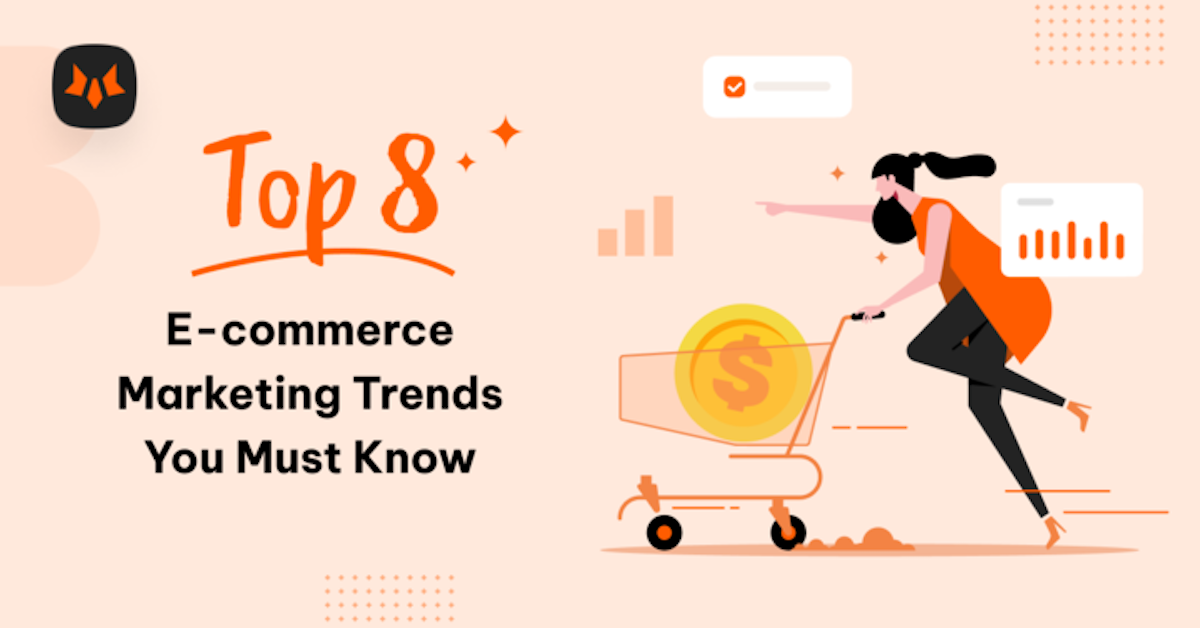Ecommerce is an ever-evolving industry, and staying ahead of the curve is vital for success. In 2025, several exciting eCommerce trends are shaping how businesses market their products and engage with customers.
Let's dive into the top 8 eCommerce marketing trends that you must know to thrive in this dynamic landscape.
1. Exceptional Online Store Design
Regarding eCommerce, your website isn't just a digital storefront; it's a critical factor that can make or break the customer experience. The design of your online store holds the power to captivate your audience, foster trust, and ultimately convert visitors into loyal customers.
In a world overflowing with digital distractions where website visitors often leave web pages within 10 to 20 seconds, a visually stunning and thoughtfully organized website is crucial to grab shoppers’ attention and initialize brand trust. Moreover, a user-friendly design with an intuitive layout can lead to longer dwell times and conversion rates.

How can you apply this trend to leverage eCommerce marketing?
Visual appealing: Since 75% of customers will judge a company’s credibility based on its website’s design, a visually appealing store-front is the cornerstone of effective design. You have to determine your website’s style first, choose some suitable layouts, and then fill in with high-quality images.
Smooth transitions and animation: Subtle transitions and animations can create a more immersive and enjoyable user experience, keeping visitors engaged and contributing to a 20% higher conversion rate. It’s ideal if you can set up small animations around the CTAs button and light transitions among web pages.
Smart use of text: Effective communication through text is crucial. You do not have space for too many words, so keep them concise and meaningful to convey your brand's message and product information clearly.
In your journey to create an exceptional online store, consider leveraging tools like Foxify. It is a smart page builder designed to enhance the aesthetics and the functionality of your online store, providing a seamless and visually appealing shopping experience for your customers.
2. Omnichannel Marketing
In the dynamic landscape of eCommerce, omnichannel marketing emerges as one of the most formidable eCommerce trends changing how businesses engage with their audiences. But what exactly is this trend, and why does it matter?
At its core, omnichannel marketing creates a seamless, unified customer experience across all touchpoints. It's the art of ensuring that whether a customer engages with your brand on your website, social media, email, or any other channel, the experience remains consistent and interconnected.
There are 2 important reasons why omnichannel marketing matters: reaching more customers and building a comprehensive shopping journey. First, extending your brand presence across multiple channels increases your chances of getting a broader audience. It's like casting a wider net to capture potential customers. Second, omnichannel marketing allows you to sell products and guide customers through a cohesive and engaging experience, from discovery to purchase.
How can you apply this trend to leverage eCommerce marketing?
Start with a strong online store: Ensure your online store is visually appealing and filled with compelling content. This serves as the hub of your omnichannel strategy.
Synchronize with social media: Integrate your website seamlessly with your social media profiles. Make it easy for customers to discover your products and share their experiences across these platforms.
Data shows that brands with strong social media engagement can see a 20-40% increase in revenue. So, store owners should elevate this power of social media.

Embrace email marketing: Email remains a powerful tool in the omnichannel arsenal. Use it to reach customers with personalized recommendations, promotions, and updates. An effectively crafted email campaign can tie all your channels together, keeping the customer journey consistent.
Utilize omnichannel marketing platforms: Many omnichannel marketing platforms currently allow store owners to execute their marketing campaigns in multiple channels effortlessly. Some popular platforms could be: Insider, ActiveCampaign, Hubspot, etc.
Let’s take StyleHub as an example. It’s a Shopify-powered fashion boutique that exemplifies the power of omnichannel marketing. After building a nice online store, StyleHub has integrated with its social media platforms, especially on Facebook and Instagram, to showcase its products and testimonials.
Moreover, StyleHub has also executed an email marketing strategy to send subscribers product recommendations and exclusive offers. By doing so, StyleHub has grown from a small boutique to a medium fashion brand in a few years.

3. Remarketing Ads
Remarketing Ads, also known as retargeting, is all about reconnecting with users who have previously interacted with your brand but didn't complete a desired action. These actions could include browsing your products, adding items to the cart, or visiting specific pages on your website.
Remarketing ads is one of the most important eCommerce trends in 2025. The importance of remarketing lies in 3 words: recapture lost opportunities. In the world of eCommerce, cart abandonment rates can be discouragingly high.
Remarketing Ads offer a lifeline, giving you a chance to bring back those lost potential customers and nudge them toward conversion. It's like extending a second invitation to your store.
How can you apply this trend to leverage eCommerce marketing?
Showcasing on the online store: You can track and target customers who have visited and interacted with your website using pixel tags and cookie data. Then, you can remarket to people who have done specific actions via a banner or sections, including previously viewed or recommended products.
Using paid ads for retargeting: Dynamic remarketing Google ads allow you to re-engage users who have visited your website or used your app. You can learn how to do it easily here.
Moreover, Social media platforms like Facebook and Instagram offer robust remarketing capabilities. You can create custom audiences based on user interactions with your website or app. Then, you can deliver targeted ads to these audiences, reminding them of your products and enticing them back to your online store.
To understand more easily, let’s take a look at Fanatics, a sportswear brand based on Shopify. The brand has tracked visitors’ behavior to showcase Google ads banners (image below) to those who have previously visited the brand’s website.

4. Video Marketing
Video Marketing stays on the top of eCommerce trends in 2025, which revolves around using video content to connect with your audience. It's a versatile medium that allows you to showcase your products, tell compelling brand stories, and interactively engage customers.
Videos are the secret sauce of eCommerce marketing. They're your ticket to capturing attention and providing entertainment, whether showcasing products, sharing behind-the-scenes glimpses, or telling engaging stories. Plus, they build trust by putting a face to your brand and demonstrating value.
Among the benefits of influencer marketing, the real kicker is that videos consistently outperform other content types with higher Click-Through Rates (CTR) and conversion rates. In fact, including video on your landing page can supercharge your conversions by up to 80%. So, if you need to incorporate video into your marketing strategy, you're missing out on a powerful tool to win over your audience.

How can you apply this trend to leverage eCommerce marketing?
Start making high-quality video content: Invest in creating professional, high-quality videos that align with your brand's identity. Possible topics could include product demonstrations, customer testimonials, "how-to" guides, or fun and engaging brand stories. Additionally, explore different video making techniques and tools to enhance your production value and captivate your audience
Execute and experiment: Social media platforms like Instagram, Facebook, and TikTok offer excellent opportunities to showcase your video content to a vast audience.
Experiment with different video formats, such as short clips, live streams, or interactive videos, to see what resonates best with your audience. Moreover, if you can get testimonials in video format, it is such an awesome way to showcase products and build trust in potential customers.
Sustainable footwear brand Allbirds has executed video marketing for a long time. They’ve produced short-form videos and also encouraged customers to create videos to publish on their branded social channels like Facebook and Instagram. Those videos attract thousands of views and engagements, which indirectly help the brand to promote its footwear and sustainable lifestyle.

5. Influencer Marketing
Influencer marketing for eCommerce is about forming collaborative partnerships with individuals, often on social media, who have established credibility and sway within their niche. These influencers have cultivated devoted followers who value their opinions and recommendations.
In recent years, influencer marketing has been a rising star among various forms of marketing and has become a trusted source of information and inspiration for customers.
The power of influencer marketing is diverse. It ranges from boosting brand awareness to improving credibility, from increasing the brand’s social following to enhancing the omnichannel experience.
However, the most important role of influencer marketing for eCommerce is humanizing brands. In which, influencers add a human touch to your brand. Their authentic, relatable content can help humanize your products or services, making them more approachable and appealing to potential customers.
How can you apply this trend to leverage eCommerce marketing?
Choose the right influencer: Carefully select influencers whose values align with your brand's identity and whose audience matches your target demographic. The authenticity of the influencer's connection with their audience is paramount. Explore how to choose the best-fit influencers for your brand here.
Develop programs for them: Collaborate with influencers to create content that resonates with their followers while subtly promoting your products or services. Ensure that the partnership feels natural and not overly promotional.
Build long-term relationships: Try to catch influencer marketing trends, but still think of influencer marketing as a long-term strategy. Nurture relationships with influencers who genuinely appreciate your brand, as ongoing partnerships can yield more significant results over time.

From the early days of Kylie Cosmetics, the brand has utilized images of Kylie Jenner (the founder, aka a celebrity) and her friends and relatives (also famous people) to promote a beauty-oriented lifestyle through the brand’s products.
Since Kylie Cosmetics has consistently used famous people's images for a long time, its products are positioned as fancy, trendy, and for famous people, attracting many customers.

6. Personalized Marketing
In today's eCommerce landscape, more than the one-size-fits-all approach is required. As a result, personalized marketing has emerged as a transformative trend that revolves around customizing your marketing strategies and content to cater to the unique preferences, behaviors, and needs of individual customers. It's about understanding your customers on a deeper level and delivering content and recommendations that resonate with their specific interests and behaviors.
The significance of personalized marketing is creating stronger connections with customers. By offering personalized experiences, you can forge stronger connections with your customers.
When customers feel understood and valued, they're more likely to engage with your brand, make purchases, and remain loyal. In fact, businesses that leverage personalized marketing see an average sales boost of 19%.

How can you apply this trend to leverage eCommerce marketing?
Data comes first: Personalization hinges on data. Collect and analyze data about your customers' browsing habits, purchase history, and preferences. This data forms the foundation upon which personalized experiences are built.
Craft tailored content: Use the insights gained from data analysis to create content that speaks directly to each customer. This might include personalized product recommendations, email content, or website experiences that cater to individual preferences.
Launch it in multi-channel: Extend personalization across various channels, ensuring a consistent and tailored customer experience, whether they're browsing your website, receiving an email, or engaging with your brand on social media.
7. Shoppable Live Streams
Shoppable live streams represent a dynamic trend that will redefine how eCommerce brands connect with their audience. At its core, Shoppable Live Streams involve hosting real-time video broadcasts where viewers can not only engage with the content but also make purchases directly within the livestream. It's akin to bringing the excitement of a physical store into the digital realm.
Given that, 87% of customers who watch live streams are more likely to purchase a product than those who don’t. Shoppable live streams offer an immersive and engaging shopping experience that transcends traditional online shopping.
It provides a unique opportunity for brands to engage with customers in real-time, answer questions, showcase products in action, and create a sense of urgency for purchases. It's a shopping experience that combines the best aspects of in-store shopping with the convenience of online browsing.

How can you apply this trend to leverage eCommerce marketing?
Determine the right platform: Choose one that aligns with your target audience. Popular options include social media platforms like Instagram, Facebook, and TikTok, which offer live-streaming capabilities and shoppable features.
Make a plan: Plan your Shoppable Live Stream carefully. Create a timeline for the event, select the products you'll feature, and consider how you'll engage with your audience during the broadcast. Interactivity is key.
Show product tips: During your Shoppable Live Stream, offer valuable tips and insights related to your products. Share user-generated content and testimonials to build trust. Encourage viewers to ask questions and participate in polls or Q&A sessions.
8. Advanced Technology
Advanced technologies continually shape the current realm of eCommerce, and three of the most prominent players in recent times are Artificial Intelligence (AI), Augmented Reality (AR), and Virtual Reality (VR). These technologies have lots of functionality and can benefit your online store.
Let’s get started with Artificial Intelligence. AI simulates human intelligence processes by machines, particularly computer systems. It encompasses various subfields like machine learning, natural language processing, and computer vision.
AI has found profound applications in eCommerce, including:
Chatbots: AI-powered chatbots provide real-time customer support, answering queries, offering product recommendations, and even facilitating transactions, all while enhancing the customer experience. Chatbots are used widely among Shopify stores. Hiut Denim, a popular Shopify store, has been using it for a while. The brand’s chatbot can reply instantly to common questions from shoppers. More than that, it can communicate via message as normal people to consult shoppers about products and services.

Personalized Product Recommendations: AI analyzes customer behavior, preferences, and purchase history to provide tailored product recommendations. This increases the likelihood of conversions and enhances customer satisfaction.
Besides, Augmented Reality (AR) overlays digital content onto the physical world, enhancing a user's perception of reality. Virtual Reality (VR), on the other hand, immerses users in entirely virtual environments through headsets or devices.
AR and VR offer exciting eCommerce possibilities, particularly in virtual shopping experiences. Shoppers can visualize products in their real-world environment using AR or immerse themselves in a virtual store environment with VR.
AR and VR in eCommerce hold significance due to their potential to:
Improving efficiency: AR can aid customers in making more informed purchase decisions, reducing returns, and increasing overall efficiency. VR can create immersive virtual showrooms, enhancing the shopping experience.
Enhancing shopping experience: AR and VR take online shopping to a new level by offering an interactive and immersive experience that closely mimics the in-store experience.

How can you apply this trend to leverage eCommerce marketing?
Don't ignore this trend: AI, AR, and VR are not fleeting eCommerce trends but transformative forces in eCommerce. Recognize their potential and embrace them in your marketing strategy.
Test and apply gradually: Familiarizing with advanced technology is a complicated task. But you can start by experimenting with these technologies on a smaller scale. For instance, deploy a chatbot or offer AR product visualization. As you gain confidence and see positive results, gradually expand your implementation.
Wrapping Up
Staying ahead means embracing the latest eCommerce trends in the rapidly evolving business world. Whether it's outstanding store design, various forms of marketing, or advanced technologies, the path to success is clear.
To start unlocking these 2025 eCommerce trends, the very first and easy step is using Foxify, a smart page builder that allows Shopify merchants to customize an awesome store-front and optimize it for future marketing efforts.
Let’s try Foxify and apply the latest eCommerce marketing trends for success






